Content for this page researched and created by Marcus Signore
House Finch
The House Finch, (Haemorhous mexicanus) is a bird in the finch family Fringillidae. It is native to western North America (All about Birds). It was introduced into eastern North America in the 1940’s via the release of cage-raised “Hollywood finches.” These birds quickly became established in the east and interbred with native purple finches (Elliot). The house finch has spread to a multitude of states and habitats across North America and Hawaii. It is very common in suburban areas and is attracted in large numbers to seed feeders.
The house finch is a relatively small bird with a longish, slightly notched tail, short wings, and a distinctively small bill with a curved culmen (the upper ridge of the bird’s bill). Many finches have notched tails but the house finch has only a shallow notch in its tail. (Alderfer). The male house finch typically has a red head, breast, and rump, but does not have red coloring on its brown back or wings. Female house finches have blurrier streaks and grayer undersides. Females also have an indistinctly marked face. The color varies among males, from pale yellow, to orange with bright red (All About Birds).
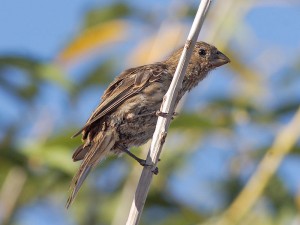
House Finches are native to open and desert habitats, but now can be found in almost any kind of human altered habitat. They are also found in wild areas such as savannas, desert grasslands and chaparral thickets (Vuilleumier). They prefer edge habitats and are absent from dense coniferous forests. While House Finches flock towards feeders during the non-breeding season, most flocks will stay together and use the bird feeder’s year round. They also often forage on the ground and perch on weeds, shrubs, and trees. The House Finches diet is mostly vegetable matter (seeds, buds, berries and nectar). They feed their young regurgitated seeds. They also eat a few small insects, especially aphids, but are primarily seed and fruit eaters at all times of the year (Bird Web). The fact remains that House Finches are easy to feed and will not starve if the insects are lacking (Valle).
House Finches also sing and may have song dialects. There are consistent differences in song patterns among House Finches. (Mundinger). Male House Finches sing a long, jumbled warbling composed of short notes. The song often ends with an upward or downward slur, and lasts about 3 seconds. Males may sing throughout the year. Females sometimes give a shorter, simpler version of the song. Compared with Cassin’s and Purple finches, House Finch songs sound slower, rougher, and somewhat less fluid. The final slurred note is more often heard in House Finches than in the other two species. Their flight all is a soft husky “fidlip” or “vweet” (Sibley).
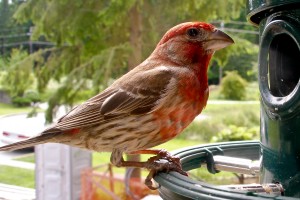
Some northern populations of House Finches are migratory, moving south in the winter. They are extending their range north into southern Canada and south into Mexico. Although House Finches do migrate, House Finches in Pennsylvania have been resident. They have rapidly spread out across the state and are now year round residents of Pennsylvania. The BBS which is the breeding bird survey reported an increase of 15% per year since 1996. But leading up to 1996 there was a 30% decrease in house finches (Mcwilliam).
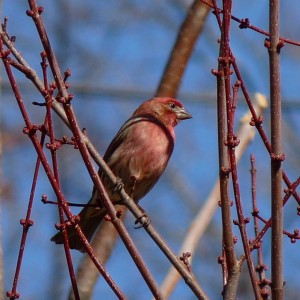
Female House finches lay four to five eggs at a time. Sometimes it can even range between 2-6 eggs. The female lays the eggs from February through August and usually takes place in the morning and at the rate of one egg per day (Veit). The eggs are pale blue, with black and lavender dots mostly at the larger end. The incubation process by the female is about 13-14 days.
After the eggs hatch, both parents feed the nestlings. The young leave the nest about 12-15 days after hatching. Up to 3 broods per year, sometimes even more are possible (Kaufman). House Finches often create a “poop wreath” of fecal sacs around the edge of the nest, as they position their themselves to defecate after feeding (Zimmerman). The cup shaped nests may be located in a wide variety of places including, conifers, palms, ivy on buildings, cactus, and even holes in man made structures (Kaufman). The nests are built mostly by females, and they consist primarily of grasses, weeds, fine twigs, leaves, rootlets. Sometimes feathers, strings, or other debris are added to the nest materials (Flanagan).
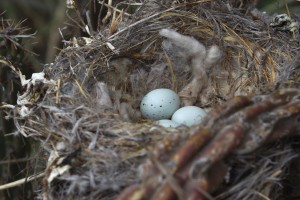
Male house finches are very dominant and competitive. Their beak size is an important factor in their visual dominance displays. Color seems to be of less importance in dominance and competition, though, and in fact highly colored, urban male house finches were shown to be less competitive than more drably colored males (Hasehawa). During courtship, males touch bills with the females and then present the females with bits of food. If the female mimics the behavior of a hungry chick, he may feed her (Veit).
House Finches are not usually aggressive unless put in a confined space with other birds. Increased contact and decreasing space increases the chances for fighting (Moyera). When choosing a mate, females from all populations showed a preference for the most brightly colored males and males with the largest patch. Even though female house finches prefer bigger patches, it is shown that they will not discriminate if a male house finch has a smaller patch (Hill).
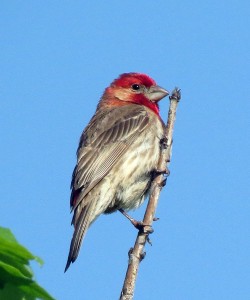
House Finches are susceptible to conjunctivitis. The symptoms of the disease are, scabby, swollen, runny, cloudy-looking, glassy eyes, mucous oozing from the nostrils, and an upper respiratory infection (Ley). Some sick birds recover, whereas others become blind and die of starvation or fall prey to cats and hawks (Salvante). The disease usually infects one eye first and then spreads to the other. Finches with partial vision loss may fly into bird feeders and windows, or allow bird-watchers to get close. The infection apparently causes some discomfort, since diseased birds frequently wipe their eyes on branches and bird feeders, possibly contributing to the spread of the disease (Adelman). This is more common within the local populations. With their eyes being shut it is very tough for them to feed themselves which is a cause of starvation (Gomizawa).
General Bibliographies
Alderfer, Jonathan K., and Gary H. Rosenberg. “Fringiline and Cardueline Finches.” National Geographic Complete Birds of North America, edited by Jonathan Alderfer,
National Geographic, Washington, D.C., 2006, pp. 631.
Flanagan, Julia. “House Finch.” House Finch. Prince William Conservation Alliance,
Gomizawa, Tamami. “Project FeederWatch. “FeederWatch House Eye Disease Comments. N.p., n.d. Wed. 05. Dec. 2016.
“House Finch.” BirdWeb. Seattle Audubon Society,
“House Finch.” Identification, All About Birds. Cornell University, 2015.
Kaufman, Kenn. “House Finch.” Audubon. National Audubon Society, 03 Mar. 2016.
Mcwilliam, Gerald M., and Daniel W. Brauning. “Fringillidae: Finches.” The Birds of Pennsylvania. Cornell University Press, Ithaca, NY, 2000, pp. 451-452.
Sibley, David. “Finches.” The Sibley Field Guide to Birds of Eastern North America, 1st ed., Alfred A. Knopf, Inc., New York, 2003, pp. 412.
Vuilleumier, François. “Finches.” Birds of North America, 1st ed., Dorling Kindersley (DK), New York, NY, 2009, pp. 564.
Zimmerman, Elizabeth Smith. “House Finch (HOFI) Nest, Egg and Young Photographs.” House Finch (HOFI) Nests, Eggs and Young.
Scientific Bibliography
Adelman, James Stephen, Ignacio Tomas Moore, and Dana Michelle Hawley. “House Finch Responses to Mycoplasma Infection DO Not Vary with Experimentally Increased Aggression. “Journal Of Experimental Zoology Part A: Ecological Genetics & Physiology 323.1 (2015): 39-51. Wildlife & Ecology Studies Worldwide. Web. 7 Nov. 2016.
Elliot, John J., and Robert S., Jr. Arbib,” Origin and status of The House Finch in The Eastern United States.” The Auk: 70.1 (1953): 31-37. Wildlife & Ecology Studies Worldwide. Web. 26 Sept. 2016
Hasehawa, Masaru, “Bayesian Estimation of Competitiveness in Male House Finches. “Animal Behavior 108(2015): 2017-214. Wildlife & Ecology Studies Worldwide. Web. 26 Sept. 2016.
Hill, Geoffrey. “Geographic Variation in Male and Female House Finch.” Journal of Behavioral Ecology, n.d. Web. 26 Sept. 2016.
Ley, David., “House Finch (Haemorhous Mexicanus) Conjunctivitis, and Mycoplasma Spp. Isolated from North American Wild Birds, 1994-2015.” Journal of Wildlife Diseases 52.3 669-673. Wildlife & Ecology Studies Worldwide. Web. 26 Sept 2016.
Moyera, Sahnzi, C., “Interactions Between Social Behavior and The Acute Immune Response in House Finche. “Behavior. 152.15(2015): 2039-2058. Wildlife & Ecology Studies Worldwide. Web. 26 Sept. 2016.
Mundinger, Paul. “Song Dialects and Colonization in the House Finch, Carpodacus Mexicanus, on the East Coast.” The Condor 77.4 (1975): 407-22. Web.
Salvante, Katrina G., “Prior Experience with Photo Stimulation Enhances Photo-Induced Reproductive Response in Female House Finches.” Journal of Biological Rhythms 28.1 (2013): 38-50. Wildlife Ecology Studies Worldwide. Web. 26 Sept. 2016.
Valle, Shelley, “Food Restriction Negatively Affects Multiple Levels of the Reproductive Axis in Male House Finches, Haemorhous Mexicanus.” Journal of Experimental Biology 218.17(2015): 2694-2704. Wildlife & Ecology Studies Worldwide. Web. 26 Sept. 2016
Veit, Richard R., and Lewis Mark A. “Dispersal, Population Growth, and the Allee Effect: Dynamics of the House Finch Invasion of Eastern North America.” The American Naturalist 148.2 (1996): 255-74. Web.
Image Gallery
(Use via Wikimedia)
- House Finch: A male House Finch in a lemon tree. Matthew Field, 2009. (permission is granted to copy, modify, or distribute this document.)
- House Finch: House Finch at a bird feeder. Matthew Field, 2009. (permission is granted to copy, modify, or distribute this document.)
- House Finch. Jim Conrad, 2009. (Jim grants anyone the right to use this work for any purpose.)
- House Finch. Cheapshot, 2012. (free to share this document.)
- House Finch eggs: Jerry Friedman, 2008. (free to copy, distribute and transmit the work.)